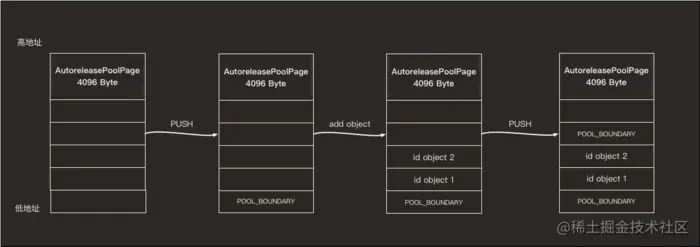autorelease 的伪代码实现
等同于以下代码
1
2
3
4
5
|
- (id)autorelease
{
[NSAutoreleasePool addObject:self];
}
|
1
2
3
4
5
6
7
8
9
10
11
12
13
14
15
|
+ (void)addObject:(id)anObj
{
NSAutoreleasePool *pool = 获取正在使用中的 pool;
if (pool != nil)
{
[pool addObject:anObj];
}
}
- (void)addObject:(id)anObj
{
[array addObject:anObj];
}
|
其中关于获取正在使用中的 pool,以下例子的 obj 在调用 autorelease 时取到的 autoreleasepool 就是 poo2
1
2
3
4
5
6
7
8
| NSAutoreleasePool *pool1 = [[NSAutoreleasePool alloc] init];
NSAutoreleasePool *pool2 = [[NSAutoreleasePool alloc] init];
NSObject *obj = [[NSObject alloc] init];
[obj autorelease]
[poo1 drain];
[poo2 drain];
|
1
2
3
4
5
6
7
8
9
10
11
12
13
14
15
16
17
18
19
|
- (void)drain
{
[self dealloc];
}
- (void)dealloc
{
[self emptyPool];
[array release];
}
- (void)emptyPool
{
for (id obj in array)
{
[obj release];
}
}
|
autorelease 苹果的实现
1
2
3
4
5
6
7
8
9
10
11
12
13
14
15
16
17
18
19
20
21
22
23
24
25
26
27
28
29
30
31
32
33
34
35
36
37
38
39
40
| class AutoreleasePoolPage
{
static inline void *push()
{
}
static inline id autorelease(id obj)
{
AutoreleasePoolPage *autoreleasePoolPage = 取得正在使用的 AutoreleasePoolPage 实例;
autoreleasePoolPage->add(obj);
}
id *add(id obj)
{
}
static inline void *pop(void *token)
{
releaseAll();
}
void releaseAll()
{
}
};
void *objc_autoreleasePoolPush(void)
{
return AutoreleasePoolPage::push();
}
void objc_autoreleasePoolPop(void *ctxt)
{
AutoreleasePoolPage::pop(ctxt);
}
id *objc_autorelease(id obj)
{
return AutoreleasePoolPage::autorelease(obj);
}
|
1
2
3
4
5
6
7
8
9
|
NSAutoreleasePool *pool=[[NSAutoreleasePool alloc] init];
id obj = [[NSObject alloc] init];
[obj autorelease];
[pool drain];
|
AutoreleasePool 的底层实现
- AutoreleasePool 是由一个个 AutoreleasePoolPage 组成的双向链表
- AutoreleasePoolPage 内部维护一个栈;栈满的时候会新建一个 AutoreleasePoolPage 节点
- AutoreleasePool Push 时会压入一个边界对象表示一个 AutoreleasePool 的开始,Pop 时会清理堆栈直到遇到一个边界对象;边界对象是界定 AutoreleasePool 的分割线

AutoreleasePool 与 RunLoop
App 启动后,苹果在主线程 RunLoop 里注册了两个 Observer,区别是优先级不同
第一个 Observer 优先级最高,保证创建释放池发生在其他所有回调之前,监视了一个事件:
- Entry(即将进入 Loop),其回调内会调用
_objc_autoreleasePoolPush() 创建自动释放池。
第二个 Observer 优先级最低,保证其释放池子发生在其他所有回调之后,监视了两个事件:
- BeforeWaiting(准备进入休眠)时调用
_objc_autoreleasePoolPop() 和 _objc_autoreleasePoolPush() 释放旧的池并创建新池;
- Exit(即将退出 Loop) 时调用
_objc_autoreleasePoolPop() 来释放自动释放池。
在主线程执行的代码,通常是写在诸如事件回调、Timer 回调内的。这些回调会被 RunLoop 创建好的 AutoreleasePool 环绕着,所以不会出现内存泄漏,开发者也不必显示创建 Pool 了
参考文章